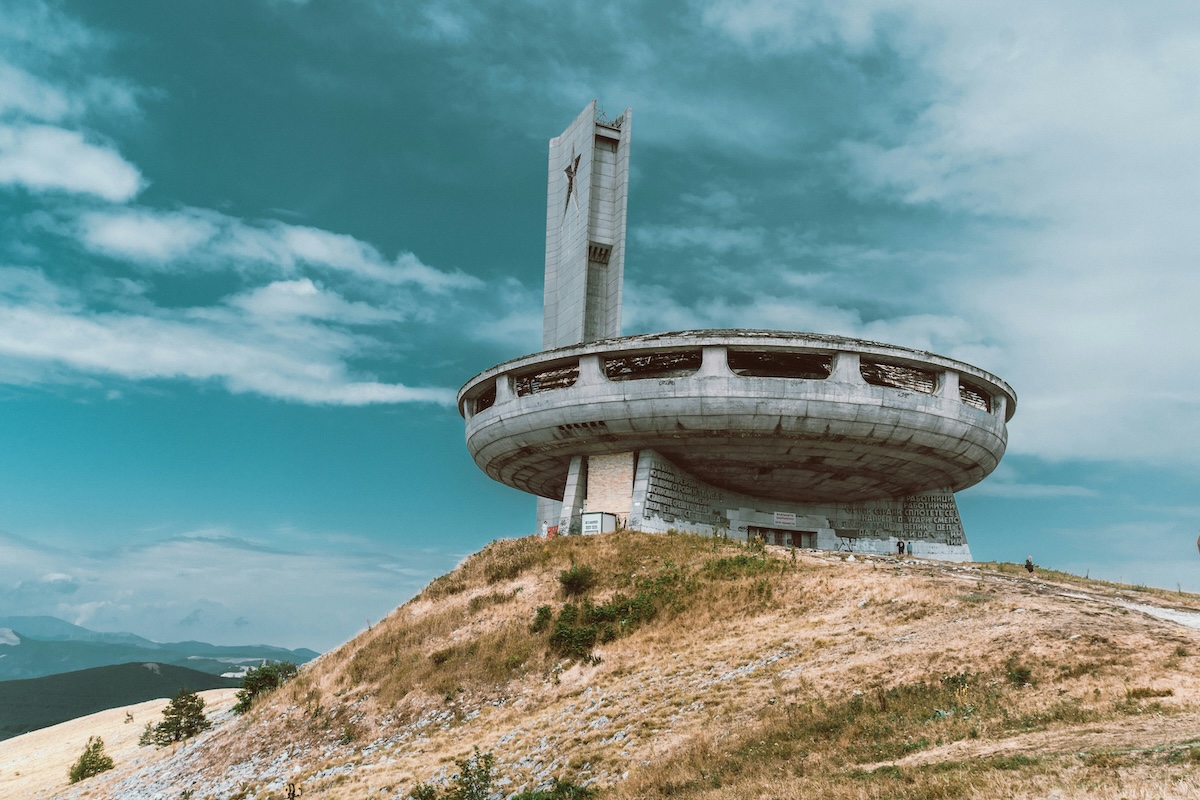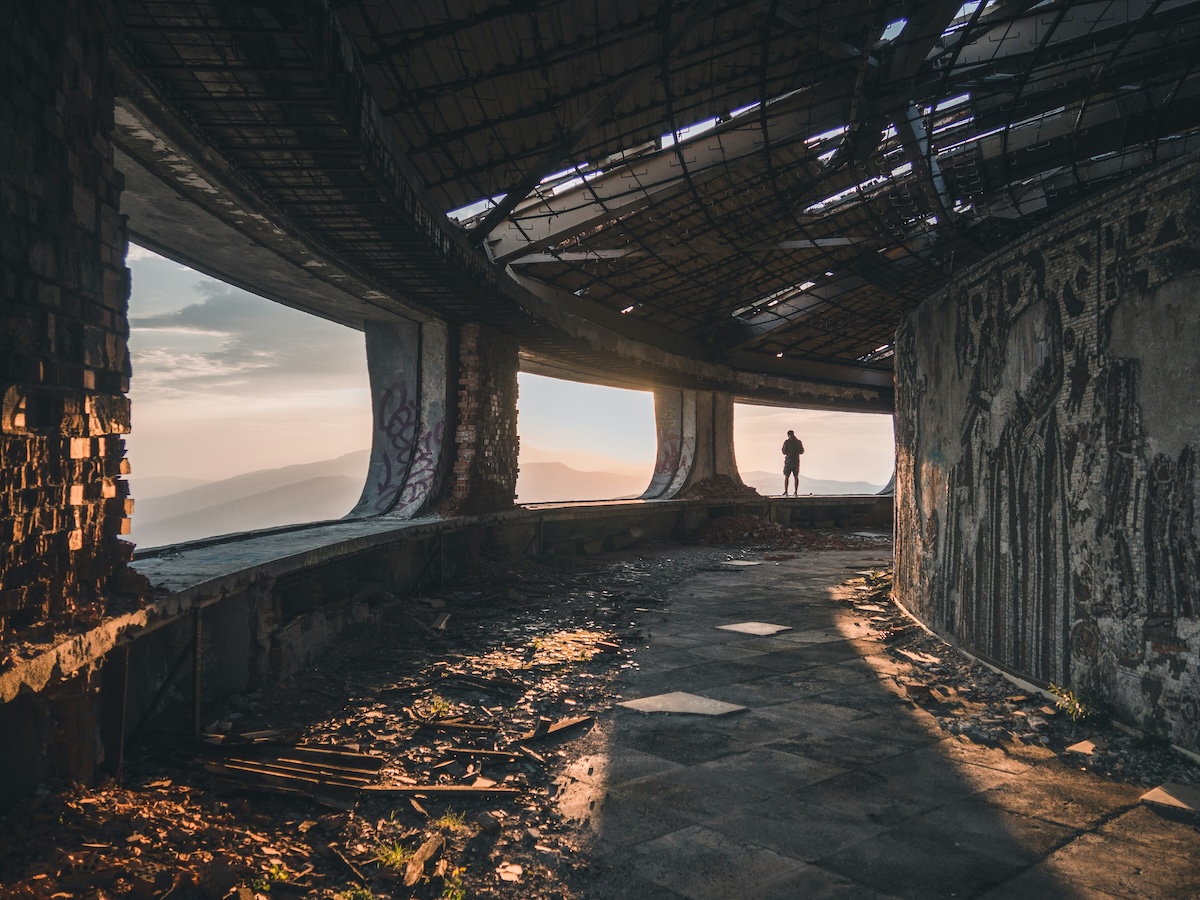
The Bulgarian Buzludzha Monument: A Soviet-Era UFO That’s a Magnet for Urban Explorers
By: Sarah Stone
Skip to Section
High on a remote mountaintop in central Bulgaria sits a massive concrete monument that looks like a decaying, crash-landed flying saucer. It’s not a movie set or an abandoned theme park—it’s Buzludzha, a massive communist-era monument that’s one of Europe’s most bizarre abandoned buildings and a magnet for adventurous travelers.
A Concrete Colossus

Photo by Alexandr Bormotin on Unsplash
Located atop a 4,700-foot peak in Bulgaria’s Balkan Mountains, the Buzludzha Monument looks like a sci-fi set. The enormous circular main building spans 195 feet across, topped with a flying-saucer-shaped roof and flanked by a 230-foot concrete tower. On clear days, you can spot this structure from nearly 20 miles away.
The monument’s location wasn’t chosen randomly. Buzludzha Peak has a special place in Bulgarian history as the site where a group of revolutionaries met secretly in 1891 to form what would later become the Bulgarian Communist Party. The monument was built to commemorate this meeting.
Construction began in 1974 and took seven years to complete, involving over 6,000 workers and more than 20 leading Bulgarian artists who created elaborate mosaics inside. The government poured the equivalent of $35 million into the project.
When it opened on August 23, 1981, Buzludzha represented the height of communist architectural ambition. The main hall featured an enormous domed ceiling covered with a mosaic that depicted communist figures alongside cosmic imagery. Star-shaped red glass windows washed the interior in an eerie crimson light. The tower displayed the world’s largest illuminated red star—larger than those atop the Kremlin towers in Moscow.
The fall of communism throughout Eastern Europe in the late 1980s left monuments like Buzludzha without purpose or funding. The Bulgarian government abandoned the site, removing anything of value. Looters stripped away copper wire, mosaics, and the red star’s glass panels. Weather and vandalism did the rest.
Buzludzha is a crumbling time capsule today. Its once-grand interior now has collapsed floors, water damage, and graffitied walls. Snow and rain blow through broken windows and holes in the roof. But for a certain type of traveler, this is an absolute must-see.
For those who do make it inside, Buzludzha is absolutely fascinating. The main hall spans 130 feet in diameter, a vast open space topped by the domed ceiling. Despite years of damage, portions of the original mosaics remain, showing idealized communist workers and leaders.
The central floor once featured a hammer and sickle emblem made from red stone. While mostly destroyed now, parts of it can still be seen among the rubble and debris. Around the outer ring, partially preserved mosaics tell the story of Bulgaria’s socialist history.
The most surreal feature might be the tower adjacent to the main building. Those willing to climb the pitch-black, debris-filled staircase (not recommended without adequate preparation) find themselves in what was once the monument’s torch—a room that housed the giant illuminated red star. From here, you can see the Balkan Mountains in all directions.
Getting to the UFO

Photo by Natalya Letunova on Unsplash
If you want to see this concrete UFO for yourself, here’s what you need to know:
The closest major city is Plovdiv, about a two-hour drive away—though if you can make it to Kazanlak, that’s about 30 minutes away from Buzludzha.
There’s no public transportation that goes directly to Buzludzha. You’ll need to rent a car or join one of the unofficial tours that sometimes depart from Plovdiv or Sofia during summer months. Take the winding mountain roads to the concrete path that climbs steeply to the monument’s peak. You’ll find no tourist facilities here—just a massive concrete structure that’s being reclaimed by nature.
Officially, you’re not allowed to enter Buzludzha. The building is structurally unsound, with concrete occasionally falling from the ceiling. Signs warn visitors of the dangers, and periodically authorities will seal entrance points with metal plates. But these barriers rarely last long because urban explorers and curious tourists always find ways in. The Bulgarian government doesn’t actively patrol the site, but police occasionally stop by, especially during summer months when visitor numbers spike.
Remember that entering the building involves risk, both physical and legal. The structure is dangerous, with real hazards to visitors. Many visitors choose to admire it from the outside only, where you can still appreciate its bizarre form against the mountain landscape.
Preservation Efforts
In recent years, preservation groups have begun advocating for Buzludzha’s protection. The Buzludzha Project works to document the monument and raise awareness about its architectural significance, separate from its political origins.
In 2018, Europa Nostra listed Buzludzha among Europe’s seven most endangered heritage sites. This designation brought renewed attention but little funding. The estimated cost to stabilize and partially restore the monument exceeds $15 million—money the Bulgarian government hasn’t been willing to provide for a symbol of its communist past.
About the Author
 As the editor-in-chief of Frayed Passport, my goal is to help you build a lifestyle that lets you travel the world whenever you want and however long you want, and not worry about where your next paycheck will come from. I've been to 20+ countries and five continents, lived for years as a full-time digital nomad, and have worked completely remotely since 2015. If you would like to share your story with our community, or partner with Frayed Passport, get in touch with me using the form on our About page.
As the editor-in-chief of Frayed Passport, my goal is to help you build a lifestyle that lets you travel the world whenever you want and however long you want, and not worry about where your next paycheck will come from. I've been to 20+ countries and five continents, lived for years as a full-time digital nomad, and have worked completely remotely since 2015. If you would like to share your story with our community, or partner with Frayed Passport, get in touch with me using the form on our About page.Featured image by Johnny Africa on Unsplash
Information published on this website and across our networks can change over time. Stories and recommendations reflect the subjective opinions of our writers. You should consult multiple sources to ensure you have the most current, safe, and correct details for your own research and plans.
Frayed Passport is a participant in the Amazon Associates Program, an affiliate advertising program designed to provide a means for sites to earn advertising fees by advertising and linking to Amazon.com. We also may share links to other affiliates and sponsors in articles across our website.




